Istanbul, Turkey, Tuesday evening, 19 June 2001
It is hard to believe that our wonderful year abroad is now coming to an end, though we are all rather looking forward to being back in the USA. Tomorrow we must all get up very early to catch an 8:20 flight from Istanbul to Athens, where after a few hours' layover we will take a noon flight to JFK.

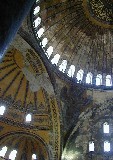
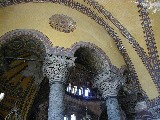 Today we visited Áyia Sofía. My heart sank when we walked in and I saw that an entire quadrant of the central dome was packed with scaffolding right down to the floor. I got over it, though, and marveled at this astonishingly spacious and airy church. It is all the more impressive when you consider its astonishingly early date: it is now almost exactly twice as old as Salisbury Cathedral, for instance, yet achieves much greater magnitude and openness of space. This I think is largely because Constantinople and the Byzantine empire remained intact when Rome fell, and so their cultural heritage from classical Greece and Rome underwent far less disruption. That classical heritage was very much a factor in the building of Áyia Sofía: for architects, the emperor Justinian engaged two mathematicians from the Athenian Academy, who had just been cashiered along with the rest of the faculty by his orders (on the principle of zero tolerance for non-Christian institutions).
Today we visited Áyia Sofía. My heart sank when we walked in and I saw that an entire quadrant of the central dome was packed with scaffolding right down to the floor. I got over it, though, and marveled at this astonishingly spacious and airy church. It is all the more impressive when you consider its astonishingly early date: it is now almost exactly twice as old as Salisbury Cathedral, for instance, yet achieves much greater magnitude and openness of space. This I think is largely because Constantinople and the Byzantine empire remained intact when Rome fell, and so their cultural heritage from classical Greece and Rome underwent far less disruption. That classical heritage was very much a factor in the building of Áyia Sofía: for architects, the emperor Justinian engaged two mathematicians from the Athenian Academy, who had just been cashiered along with the rest of the faculty by his orders (on the principle of zero tolerance for non-Christian institutions).

 Interior mosaics here, though no part of the original contruction, are said to have amounted to four acres at one time.
Interior mosaics here, though no part of the original contruction, are said to have amounted to four acres at one time.

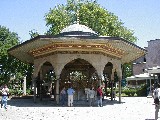 At left, the partition dividing the general women's gallery from the private imperial enclosure was styled by the Turks the "Gates of Heaven and Hell"--but which side was which? At right, the eighteenth-century ablution fountain just outside recalls the Gate of Felicity at Topkapi Palace.
At left, the partition dividing the general women's gallery from the private imperial enclosure was styled by the Turks the "Gates of Heaven and Hell"--but which side was which? At right, the eighteenth-century ablution fountain just outside recalls the Gate of Felicity at Topkapi Palace.
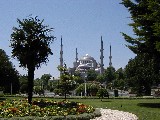 Just as the best exterior view of Áyia Sofía is to be had from just in front of the Blue Mosque, so the best exterior view of the Blue Mosque is to be had from just by Áyia Sofía, across Sultanahmet Square.
Just as the best exterior view of Áyia Sofía is to be had from just in front of the Blue Mosque, so the best exterior view of the Blue Mosque is to be had from just by Áyia Sofía, across Sultanahmet Square.
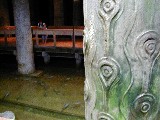
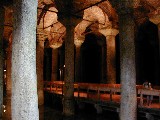
 Our final sightseeing expedition of the day (and our year!) was to the vast underground reservoir, of about the same period as Áyia Sofía. I recalled a scene down here in one of the James Bond movies, but I could not and cannot recall which one and the Turks could not help me on that. Large carp and smaller fish seem to thrive down here. Our self-appointed guide said they were fed bread. Some decoratively carved stone pieces made their way at second hand into the construction, which would never normally have seen the light of day; they include two colossal heads of Medusa that did not even wind up right side up, for a decided weird effect.
Our final sightseeing expedition of the day (and our year!) was to the vast underground reservoir, of about the same period as Áyia Sofía. I recalled a scene down here in one of the James Bond movies, but I could not and cannot recall which one and the Turks could not help me on that. Large carp and smaller fish seem to thrive down here. Our self-appointed guide said they were fed bread. Some decoratively carved stone pieces made their way at second hand into the construction, which would never normally have seen the light of day; they include two colossal heads of Medusa that did not even wind up right side up, for a decided weird effect.
When we came up into daylight again, our guide did not let us go until he had conducted us to his brother's rug shop, where the two of them had a very hard go indeed at selling us another rug. We were served tea, a standard part of the ritual (the girls have grown quite fond of elma çayi or apple tea), and we went along with the process of selecting a favorite; but were resolved against purchase, and stayed so, and told them so, which had a miraculous effect on the price. While we were at lunch outdoors just across the way afterwards, our guide Halli came by and made us a final offer less than half of their first.
After a final and brief visit back to the Grand Bazaar for a few presents to bring home we went back to our hotel to pack and prepare for the trip home to the USA.
previous entry
main/ToC page


 Today we visited Áyia Sofía. My heart sank when we walked in and I saw that an entire quadrant of the central dome was packed with scaffolding right down to the floor. I got over it, though, and marveled at this astonishingly spacious and airy church. It is all the more impressive when you consider its astonishingly early date: it is now almost exactly twice as old as Salisbury Cathedral, for instance, yet achieves much greater magnitude and openness of space. This I think is largely because Constantinople and the Byzantine empire remained intact when Rome fell, and so their cultural heritage from classical Greece and Rome underwent far less disruption. That classical heritage was very much a factor in the building of Áyia Sofía: for architects, the emperor Justinian engaged two mathematicians from the Athenian Academy, who had just been cashiered along with the rest of the faculty by his orders (on the principle of zero tolerance for non-Christian institutions).
Today we visited Áyia Sofía. My heart sank when we walked in and I saw that an entire quadrant of the central dome was packed with scaffolding right down to the floor. I got over it, though, and marveled at this astonishingly spacious and airy church. It is all the more impressive when you consider its astonishingly early date: it is now almost exactly twice as old as Salisbury Cathedral, for instance, yet achieves much greater magnitude and openness of space. This I think is largely because Constantinople and the Byzantine empire remained intact when Rome fell, and so their cultural heritage from classical Greece and Rome underwent far less disruption. That classical heritage was very much a factor in the building of Áyia Sofía: for architects, the emperor Justinian engaged two mathematicians from the Athenian Academy, who had just been cashiered along with the rest of the faculty by his orders (on the principle of zero tolerance for non-Christian institutions).







